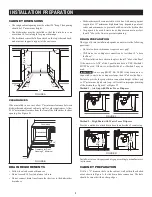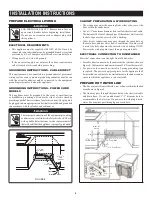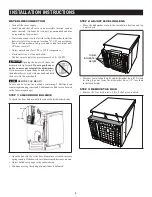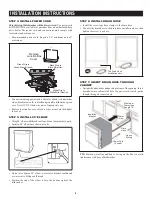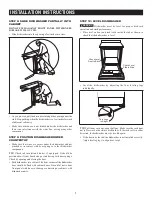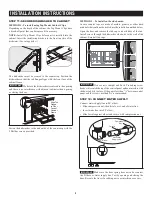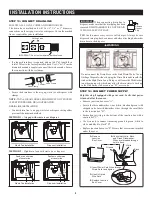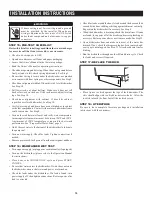
10
INSTALLATION INSTRUCTIONS
WARNING
If house wiring is not 2-wire with ground, a ground
must be provided by the installer. When house
wiring is aluminum, be sure to use cUL/UL Listed
antioxidant compound and aluminum-to-copper
connectors.
STEP 15: PRE-TEST CHECKLIST
Review this list after installing your dishwasher to avoid charges
for a service call that is not covered by your warranty.
• Check to be sure power is OFF.
• Open door and remove all foam and paper packaging.
• Locate the Owner’s Manual in the literature package.
• Read the Owner’s Manual for operating instructions.
• Check door opening and closing. If door does not open and close
freely or tends to fall, check spring adjustments. See Step 1.
• Be sure that wiring is secure under the dishwasher, not pinched
or in contact with door springs or other components. See Step 9.
• Check door alignment with tub. If door hits tub, level dishwasher.
See Step 10.
• Pull lower rack out, about halfway. Make sure it does not roll
back or forward on the door. If the rack moves, adjust leveling
legs. See Step 10.
• Check door alignment with cabinet. If door hits cabinet,
reposition or relevel dishwasher. See Step 10.
• Verify water supply and drain lines are not kinked or in contact
with other components. Contact with motor or dishwasher frame
could cause noise. See Step 8.
• Turn on the sink hot water faucet and verify water temperature.
Incoming water temperature must be between 120°F and 150°F.
A minimum of 120°F temperature is required for best wash
performance. See “Prepare Hot Water Line,” page 4.
• Add 2 liters of water to the bottom of the dishwasher to lubricate
the pump seal.
• Turn on water supply. Check for leaks. Tighten connections if
needed.
•
Remove protective film if present from the control panel and door.
STEP 16: DISHWASHER WET TEST
• Turn on power supply (or plug power cord into outlet, if equipped).
• Turn on the dishwasher (please refer to the Operation Manual
for instructions).
• Close door, select RINSE ONLY cycle and press START/
CANCEL.
• Be sure that water enters the dishwasher. If water does not enter
the dishwasher, ensure that water and power are turned on.
• Check for leaks under the dishwasher. If a leak is found, turn
power supply off, then tighten connections. Restore power after
leak is corrected.
• Check for leaks around the door. A leak around the door could be
caused by the door rubbing or hitting against adjacent cabinetry.
Reposition the dishwasher if necessary. See Step 9.
• When the dishwasher is draining, check the drain lines. If leaks
are found, turn power off at the breaker and correct plumbing as
necessary. Restore power after corrections are made. See Step 12.
• Open dishwasher door and make sure most of the water has
drained. If not, check that disposer plug has been removed and/
or air gap is not plugged. See Step 13. Also check drain line for
kinking.
•
Run the dishwasher through another fill and drain cycle. Check
for leaks and correct if required.
STEP 17: REPLACE TOE KICK
• Place 1-piece toe kick against the legs of the dishwasher. The
slots should align with toe kick bracket screw holes. Allow the
toe kick to touch the floor. Install the toe kick screws.
STEP 18: LITERATURE
Be sure to leave complete literature package and installation
instructions with the consumer.



